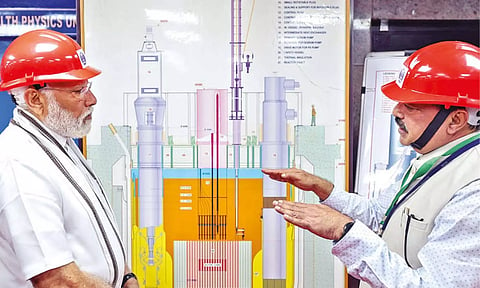

CHENNAI: Prime Minister Narendra Modi on Monday witnessed the commencement of ‘core loading’ of the country’s indigenous Prototype Fast Breeder Reactor (PFBR) at Kalpakkam, located about 60 km from here.
India is now just a step away from entering the second stage of its nuclear programme with the initiation of the core loading a move described as ‘historic’ by the government.
Prime Minister Narendra Modi toured the reactor vault and the control room of the PFBR along with National Security Adviser Ajit Doval, Atomic Energy Commission Chairman AK Mohanty, Bhabha Atomic Research Center Director Vivek Bhasin and Indira Gandhi Centre for Atomic Research Director B Venkataraman.
The 500 MW fast breeder reactor was designed and constructed indigenously by Bharatiya Nabhikiya Vidyut Nigam Limited (BHAVINI), created in 2003. Once commissioned, India will only be the second country after Russia to have a commercially operating Fast Breeder Reactor.An official release said that upon completion of the core loading, the first approach to criticality will be achieved, subsequently leading to power generation. Despite the advanced technology involved, both the capital and the per-unit electricity costs are comparable to other nuclear and conventional power plants.
The Fast Breeder Reactor (FBR) will initially use the Uranium-Plutonium Mixed Oxide (MOX) fuel. The Uranium-238 “blanket” surrounding the fuel core will undergo nuclear transmutation to produce more fuel, thus earning the name ‘Breeder’.
The use of Throium-232, which in itself is not a fissile material, as a blanket is also envisaged in this stage. By transmutation, Thorium will create fissile Uranium-233 which will be used as fuel in the third stage.
FBR is thus a stepping stone for the third stage of the program paving the way for the eventual full utilisation of India’s abundant thorium reserves. The FBRs are also important from a strategic point of view. In terms of safety, the PFBR is an advanced third-generation reactor with inherent passive safety features ensuring a prompt and safe shutdown of the plant in the event of an emergency.
Since it uses the spent fuel from the first stage, FBR also offers a great advantage in terms of a significant reduction in nuclear waste.